Research Proposal: Causes of Youth Inactivity and Health Impacts
VerifiedAdded on 2022/09/15
|12
|2231
|22
Report
AI Summary
This research proposal explores the increasing trend of youth inactivity and its impact on health. It begins with an introduction that highlights the problem of reduced participation in extracurricular activities and the rise of internet and technology addiction among young people, leading to mental and physical health concerns. The study aims to identify the causes of youth inactivity, analyze its long-term health effects, and propose motivational initiatives. The literature review examines the existing research, highlighting the negative health consequences of inactivity, such as obesity and cardiovascular issues, and the varying rates of inactivity across different demographics and regions. The methodology section outlines a qualitative research approach using positivism as the research philosophy and a deductive approach, employing descriptive research design. Data will be collected through interviews with health professionals and young participants, using ethical considerations like data protection. The proposal also acknowledges research limitations like potential bias and time constraints, and provides a detailed timeline for the research process, including data collection, analysis, and report writing. The research question focuses on the causes of youth inactivity and its health impacts, aiming to contribute to the understanding of changing living standards and public health.
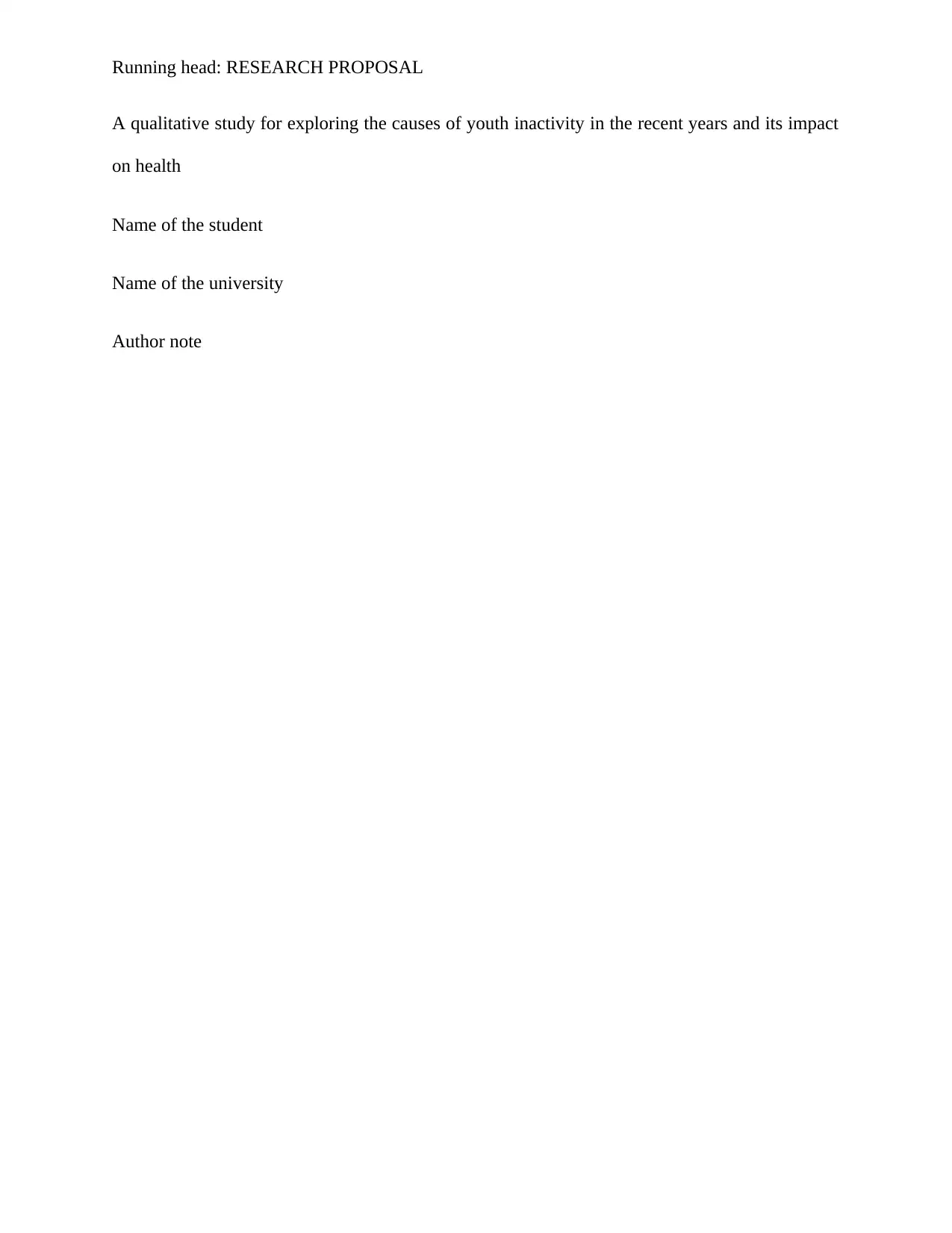
Running head: RESEARCH PROPOSAL
A qualitative study for exploring the causes of youth inactivity in the recent years and its impact
on health
Name of the student
Name of the university
Author note
A qualitative study for exploring the causes of youth inactivity in the recent years and its impact
on health
Name of the student
Name of the university
Author note
Paraphrase This Document
Need a fresh take? Get an instant paraphrase of this document with our AI Paraphraser
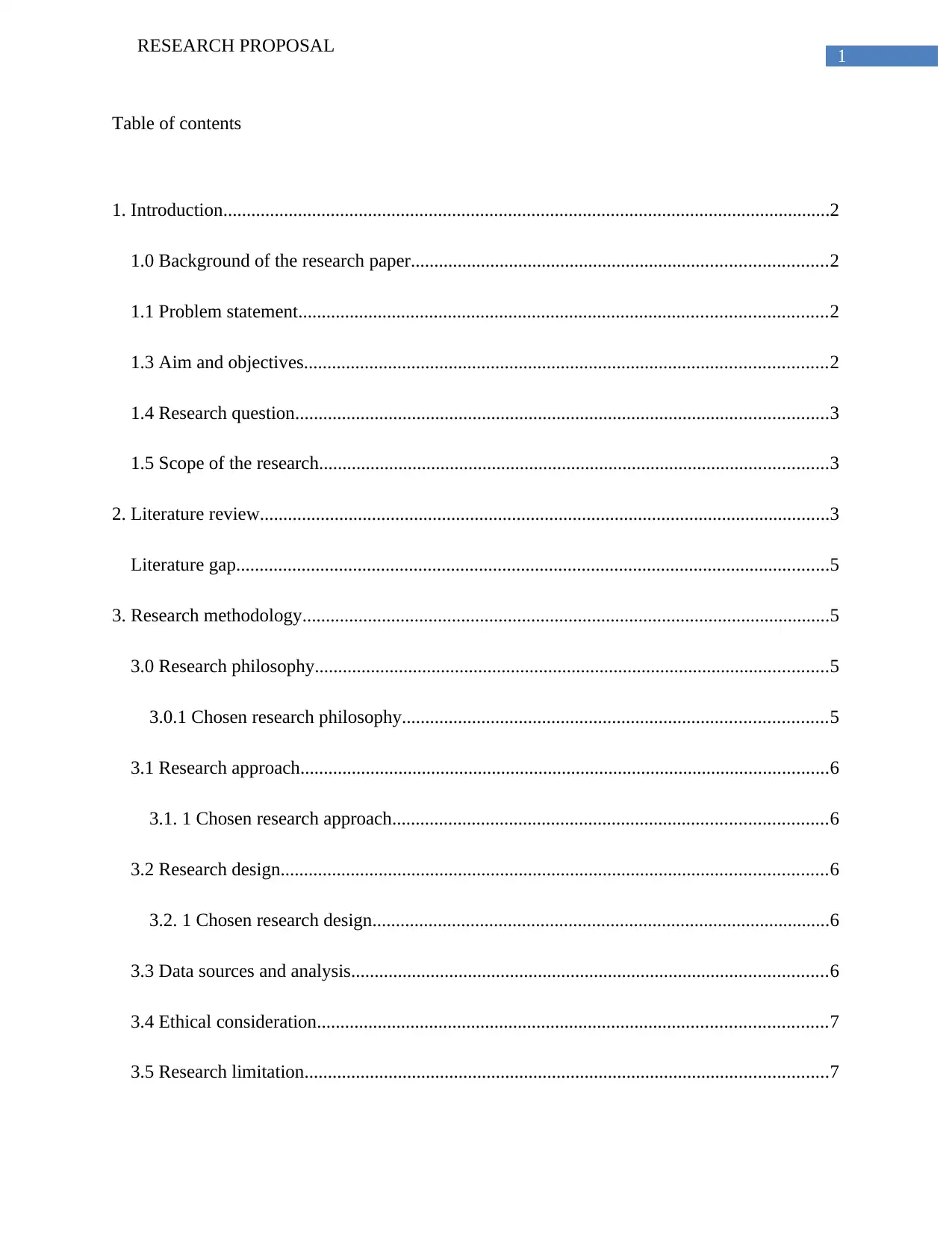
1
RESEARCH PROPOSAL
Table of contents
1. Introduction..................................................................................................................................2
1.0 Background of the research paper.........................................................................................2
1.1 Problem statement.................................................................................................................2
1.3 Aim and objectives................................................................................................................2
1.4 Research question..................................................................................................................3
1.5 Scope of the research.............................................................................................................3
2. Literature review..........................................................................................................................3
Literature gap...............................................................................................................................5
3. Research methodology.................................................................................................................5
3.0 Research philosophy..............................................................................................................5
3.0.1 Chosen research philosophy...........................................................................................5
3.1 Research approach.................................................................................................................6
3.1. 1 Chosen research approach.............................................................................................6
3.2 Research design.....................................................................................................................6
3.2. 1 Chosen research design..................................................................................................6
3.3 Data sources and analysis......................................................................................................6
3.4 Ethical consideration.............................................................................................................7
3.5 Research limitation................................................................................................................7
RESEARCH PROPOSAL
Table of contents
1. Introduction..................................................................................................................................2
1.0 Background of the research paper.........................................................................................2
1.1 Problem statement.................................................................................................................2
1.3 Aim and objectives................................................................................................................2
1.4 Research question..................................................................................................................3
1.5 Scope of the research.............................................................................................................3
2. Literature review..........................................................................................................................3
Literature gap...............................................................................................................................5
3. Research methodology.................................................................................................................5
3.0 Research philosophy..............................................................................................................5
3.0.1 Chosen research philosophy...........................................................................................5
3.1 Research approach.................................................................................................................6
3.1. 1 Chosen research approach.............................................................................................6
3.2 Research design.....................................................................................................................6
3.2. 1 Chosen research design..................................................................................................6
3.3 Data sources and analysis......................................................................................................6
3.4 Ethical consideration.............................................................................................................7
3.5 Research limitation................................................................................................................7
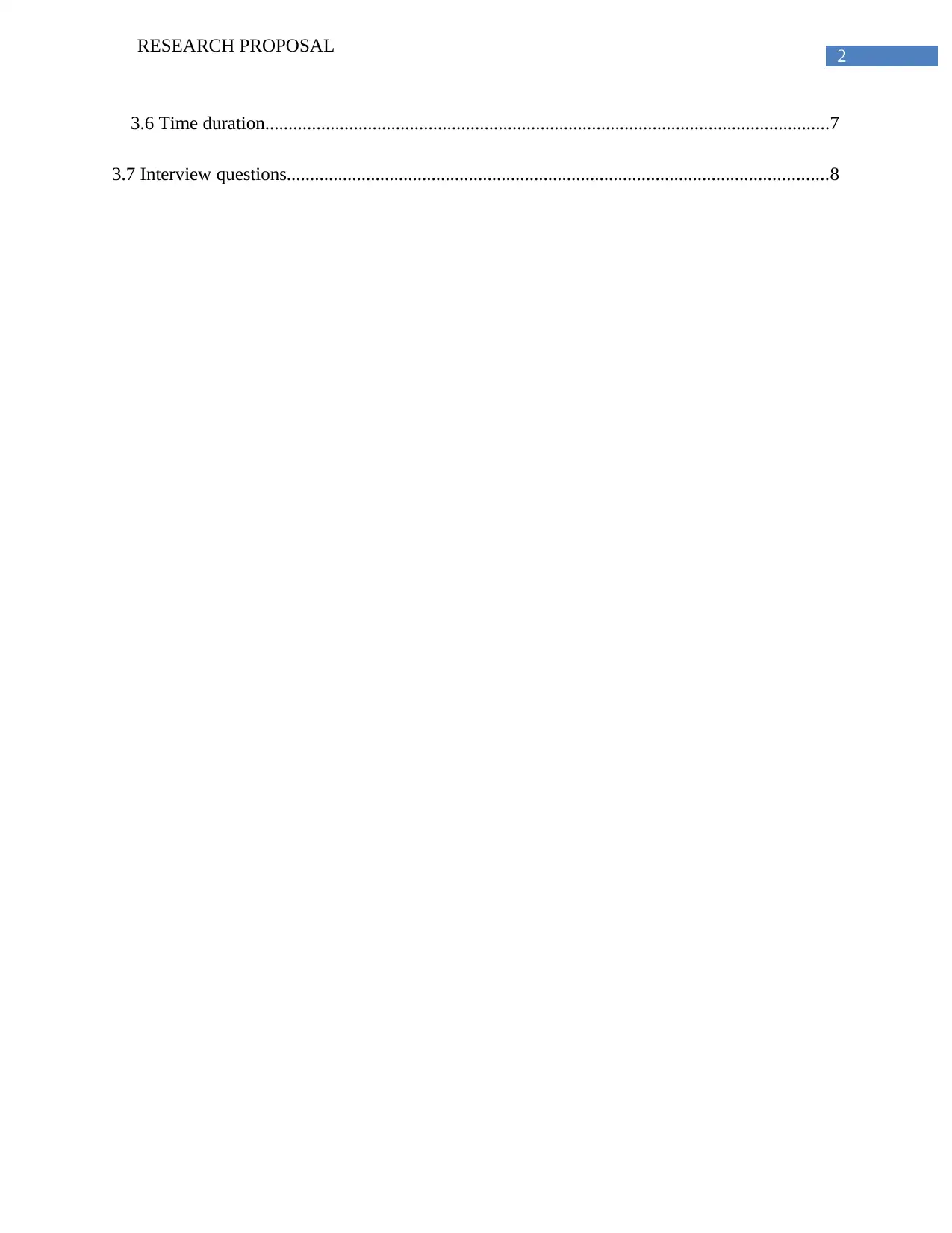
2
RESEARCH PROPOSAL
3.6 Time duration.........................................................................................................................7
3.7 Interview questions....................................................................................................................8
RESEARCH PROPOSAL
3.6 Time duration.........................................................................................................................7
3.7 Interview questions....................................................................................................................8
⊘ This is a preview!⊘
Do you want full access?
Subscribe today to unlock all pages.

Trusted by 1+ million students worldwide
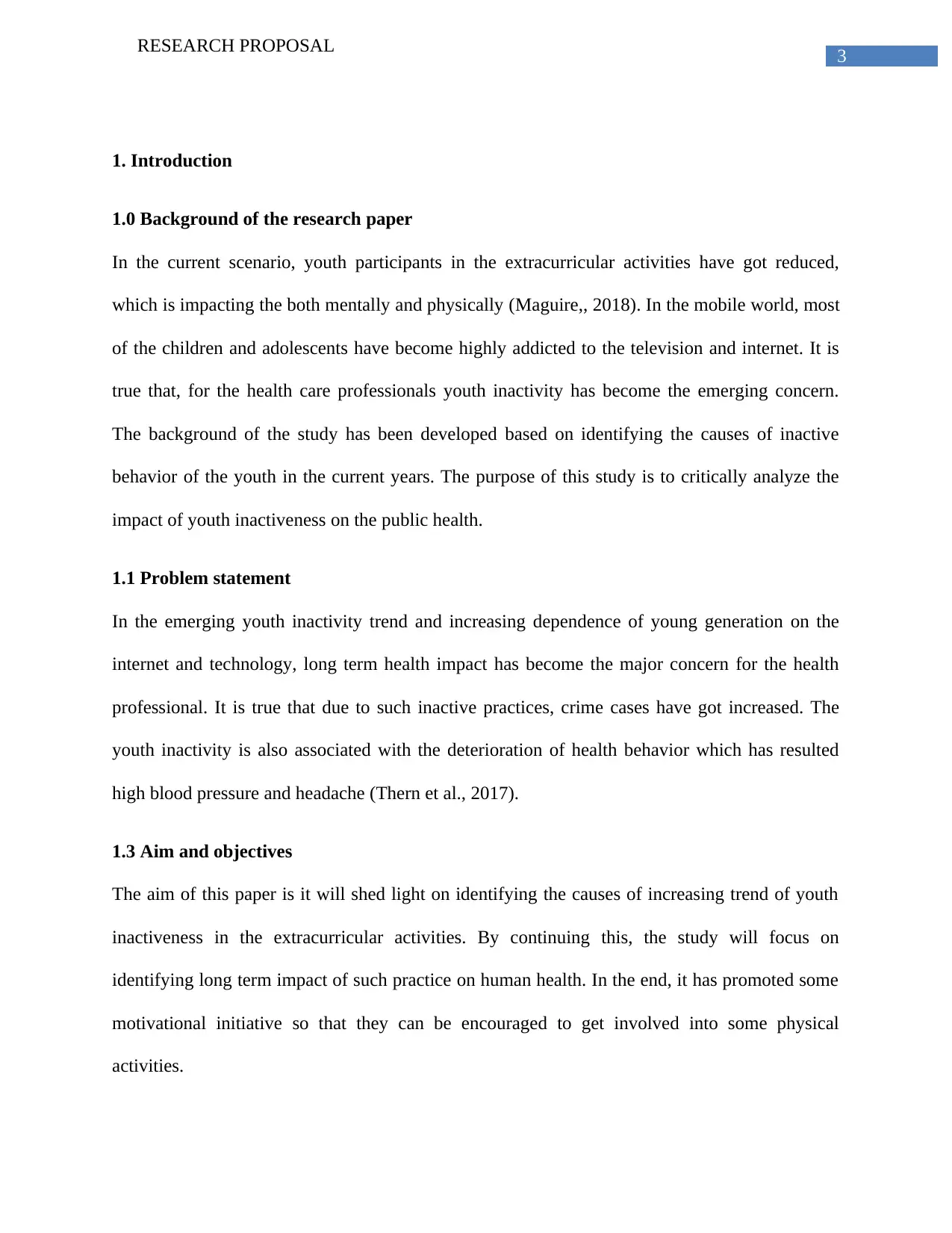
3
RESEARCH PROPOSAL
1. Introduction
1.0 Background of the research paper
In the current scenario, youth participants in the extracurricular activities have got reduced,
which is impacting the both mentally and physically (Maguire,, 2018). In the mobile world, most
of the children and adolescents have become highly addicted to the television and internet. It is
true that, for the health care professionals youth inactivity has become the emerging concern.
The background of the study has been developed based on identifying the causes of inactive
behavior of the youth in the current years. The purpose of this study is to critically analyze the
impact of youth inactiveness on the public health.
1.1 Problem statement
In the emerging youth inactivity trend and increasing dependence of young generation on the
internet and technology, long term health impact has become the major concern for the health
professional. It is true that due to such inactive practices, crime cases have got increased. The
youth inactivity is also associated with the deterioration of health behavior which has resulted
high blood pressure and headache (Thern et al., 2017).
1.3 Aim and objectives
The aim of this paper is it will shed light on identifying the causes of increasing trend of youth
inactiveness in the extracurricular activities. By continuing this, the study will focus on
identifying long term impact of such practice on human health. In the end, it has promoted some
motivational initiative so that they can be encouraged to get involved into some physical
activities.
RESEARCH PROPOSAL
1. Introduction
1.0 Background of the research paper
In the current scenario, youth participants in the extracurricular activities have got reduced,
which is impacting the both mentally and physically (Maguire,, 2018). In the mobile world, most
of the children and adolescents have become highly addicted to the television and internet. It is
true that, for the health care professionals youth inactivity has become the emerging concern.
The background of the study has been developed based on identifying the causes of inactive
behavior of the youth in the current years. The purpose of this study is to critically analyze the
impact of youth inactiveness on the public health.
1.1 Problem statement
In the emerging youth inactivity trend and increasing dependence of young generation on the
internet and technology, long term health impact has become the major concern for the health
professional. It is true that due to such inactive practices, crime cases have got increased. The
youth inactivity is also associated with the deterioration of health behavior which has resulted
high blood pressure and headache (Thern et al., 2017).
1.3 Aim and objectives
The aim of this paper is it will shed light on identifying the causes of increasing trend of youth
inactiveness in the extracurricular activities. By continuing this, the study will focus on
identifying long term impact of such practice on human health. In the end, it has promoted some
motivational initiative so that they can be encouraged to get involved into some physical
activities.
Paraphrase This Document
Need a fresh take? Get an instant paraphrase of this document with our AI Paraphraser
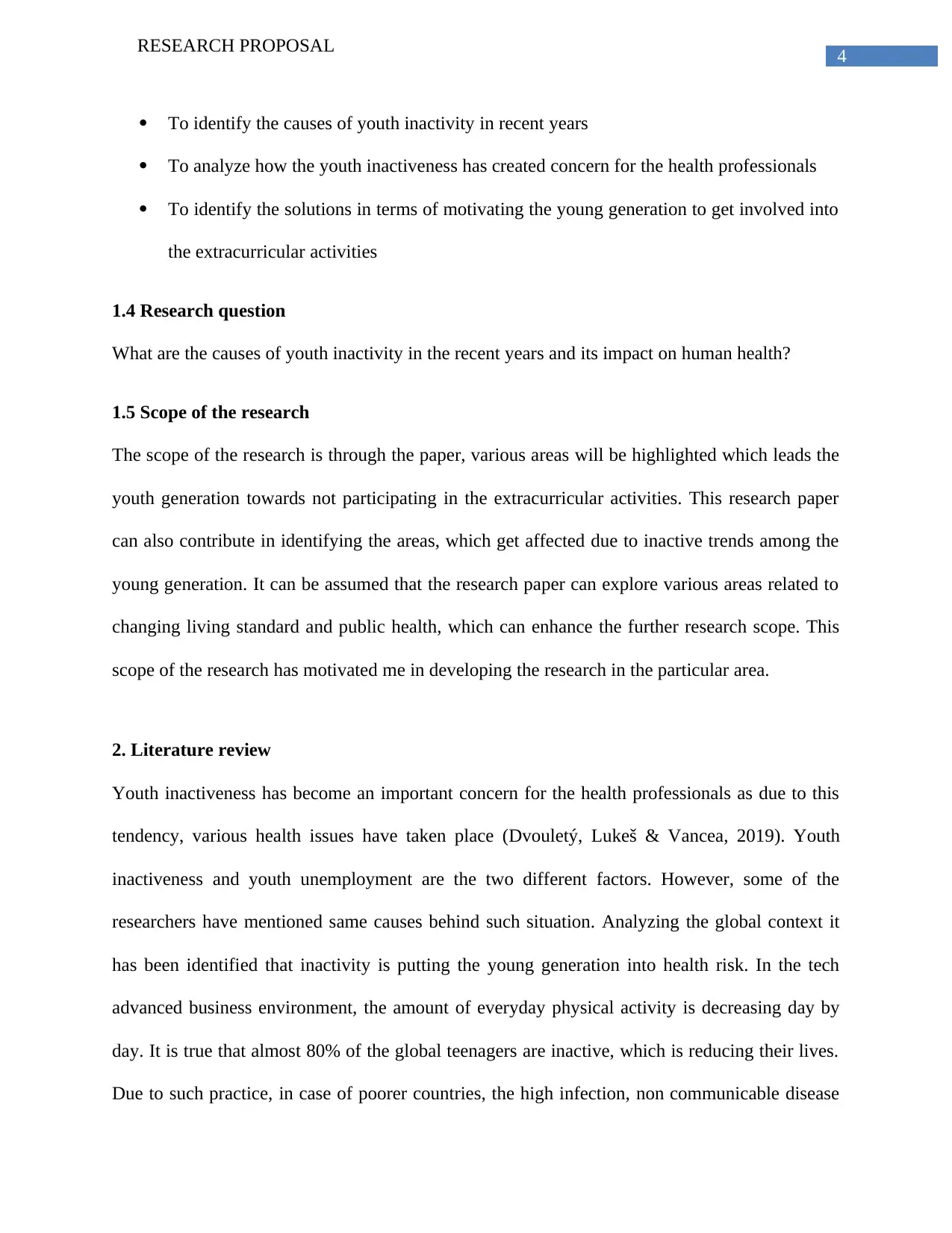
4
RESEARCH PROPOSAL
To identify the causes of youth inactivity in recent years
To analyze how the youth inactiveness has created concern for the health professionals
To identify the solutions in terms of motivating the young generation to get involved into
the extracurricular activities
1.4 Research question
What are the causes of youth inactivity in the recent years and its impact on human health?
1.5 Scope of the research
The scope of the research is through the paper, various areas will be highlighted which leads the
youth generation towards not participating in the extracurricular activities. This research paper
can also contribute in identifying the areas, which get affected due to inactive trends among the
young generation. It can be assumed that the research paper can explore various areas related to
changing living standard and public health, which can enhance the further research scope. This
scope of the research has motivated me in developing the research in the particular area.
2. Literature review
Youth inactiveness has become an important concern for the health professionals as due to this
tendency, various health issues have taken place (Dvouletý, Lukeš & Vancea, 2019). Youth
inactiveness and youth unemployment are the two different factors. However, some of the
researchers have mentioned same causes behind such situation. Analyzing the global context it
has been identified that inactivity is putting the young generation into health risk. In the tech
advanced business environment, the amount of everyday physical activity is decreasing day by
day. It is true that almost 80% of the global teenagers are inactive, which is reducing their lives.
Due to such practice, in case of poorer countries, the high infection, non communicable disease
RESEARCH PROPOSAL
To identify the causes of youth inactivity in recent years
To analyze how the youth inactiveness has created concern for the health professionals
To identify the solutions in terms of motivating the young generation to get involved into
the extracurricular activities
1.4 Research question
What are the causes of youth inactivity in the recent years and its impact on human health?
1.5 Scope of the research
The scope of the research is through the paper, various areas will be highlighted which leads the
youth generation towards not participating in the extracurricular activities. This research paper
can also contribute in identifying the areas, which get affected due to inactive trends among the
young generation. It can be assumed that the research paper can explore various areas related to
changing living standard and public health, which can enhance the further research scope. This
scope of the research has motivated me in developing the research in the particular area.
2. Literature review
Youth inactiveness has become an important concern for the health professionals as due to this
tendency, various health issues have taken place (Dvouletý, Lukeš & Vancea, 2019). Youth
inactiveness and youth unemployment are the two different factors. However, some of the
researchers have mentioned same causes behind such situation. Analyzing the global context it
has been identified that inactivity is putting the young generation into health risk. In the tech
advanced business environment, the amount of everyday physical activity is decreasing day by
day. It is true that almost 80% of the global teenagers are inactive, which is reducing their lives.
Due to such practice, in case of poorer countries, the high infection, non communicable disease
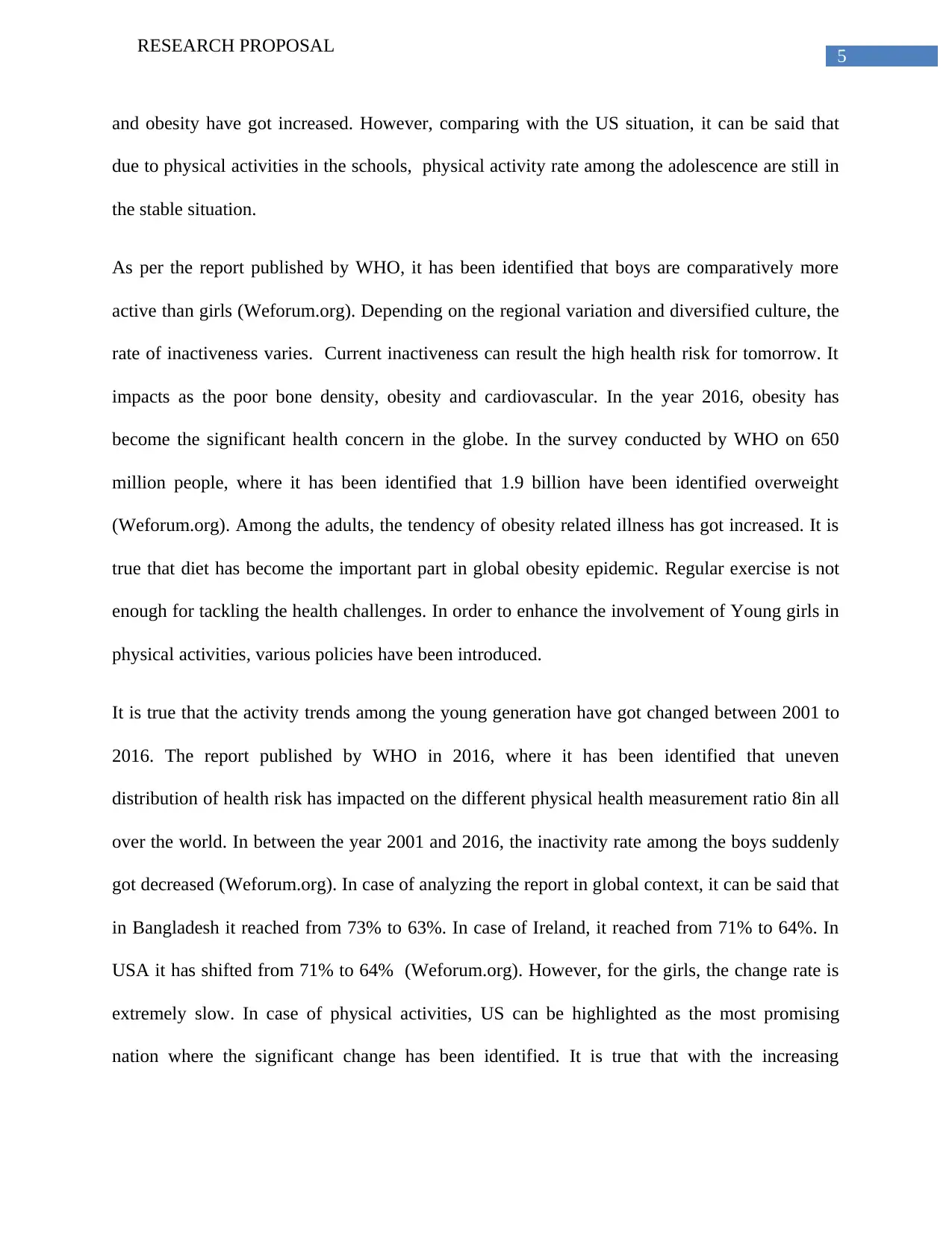
5
RESEARCH PROPOSAL
and obesity have got increased. However, comparing with the US situation, it can be said that
due to physical activities in the schools, physical activity rate among the adolescence are still in
the stable situation.
As per the report published by WHO, it has been identified that boys are comparatively more
active than girls (Weforum.org). Depending on the regional variation and diversified culture, the
rate of inactiveness varies. Current inactiveness can result the high health risk for tomorrow. It
impacts as the poor bone density, obesity and cardiovascular. In the year 2016, obesity has
become the significant health concern in the globe. In the survey conducted by WHO on 650
million people, where it has been identified that 1.9 billion have been identified overweight
(Weforum.org). Among the adults, the tendency of obesity related illness has got increased. It is
true that diet has become the important part in global obesity epidemic. Regular exercise is not
enough for tackling the health challenges. In order to enhance the involvement of Young girls in
physical activities, various policies have been introduced.
It is true that the activity trends among the young generation have got changed between 2001 to
2016. The report published by WHO in 2016, where it has been identified that uneven
distribution of health risk has impacted on the different physical health measurement ratio 8in all
over the world. In between the year 2001 and 2016, the inactivity rate among the boys suddenly
got decreased (Weforum.org). In case of analyzing the report in global context, it can be said that
in Bangladesh it reached from 73% to 63%. In case of Ireland, it reached from 71% to 64%. In
USA it has shifted from 71% to 64% (Weforum.org). However, for the girls, the change rate is
extremely slow. In case of physical activities, US can be highlighted as the most promising
nation where the significant change has been identified. It is true that with the increasing
RESEARCH PROPOSAL
and obesity have got increased. However, comparing with the US situation, it can be said that
due to physical activities in the schools, physical activity rate among the adolescence are still in
the stable situation.
As per the report published by WHO, it has been identified that boys are comparatively more
active than girls (Weforum.org). Depending on the regional variation and diversified culture, the
rate of inactiveness varies. Current inactiveness can result the high health risk for tomorrow. It
impacts as the poor bone density, obesity and cardiovascular. In the year 2016, obesity has
become the significant health concern in the globe. In the survey conducted by WHO on 650
million people, where it has been identified that 1.9 billion have been identified overweight
(Weforum.org). Among the adults, the tendency of obesity related illness has got increased. It is
true that diet has become the important part in global obesity epidemic. Regular exercise is not
enough for tackling the health challenges. In order to enhance the involvement of Young girls in
physical activities, various policies have been introduced.
It is true that the activity trends among the young generation have got changed between 2001 to
2016. The report published by WHO in 2016, where it has been identified that uneven
distribution of health risk has impacted on the different physical health measurement ratio 8in all
over the world. In between the year 2001 and 2016, the inactivity rate among the boys suddenly
got decreased (Weforum.org). In case of analyzing the report in global context, it can be said that
in Bangladesh it reached from 73% to 63%. In case of Ireland, it reached from 71% to 64%. In
USA it has shifted from 71% to 64% (Weforum.org). However, for the girls, the change rate is
extremely slow. In case of physical activities, US can be highlighted as the most promising
nation where the significant change has been identified. It is true that with the increasing
⊘ This is a preview!⊘
Do you want full access?
Subscribe today to unlock all pages.

Trusted by 1+ million students worldwide
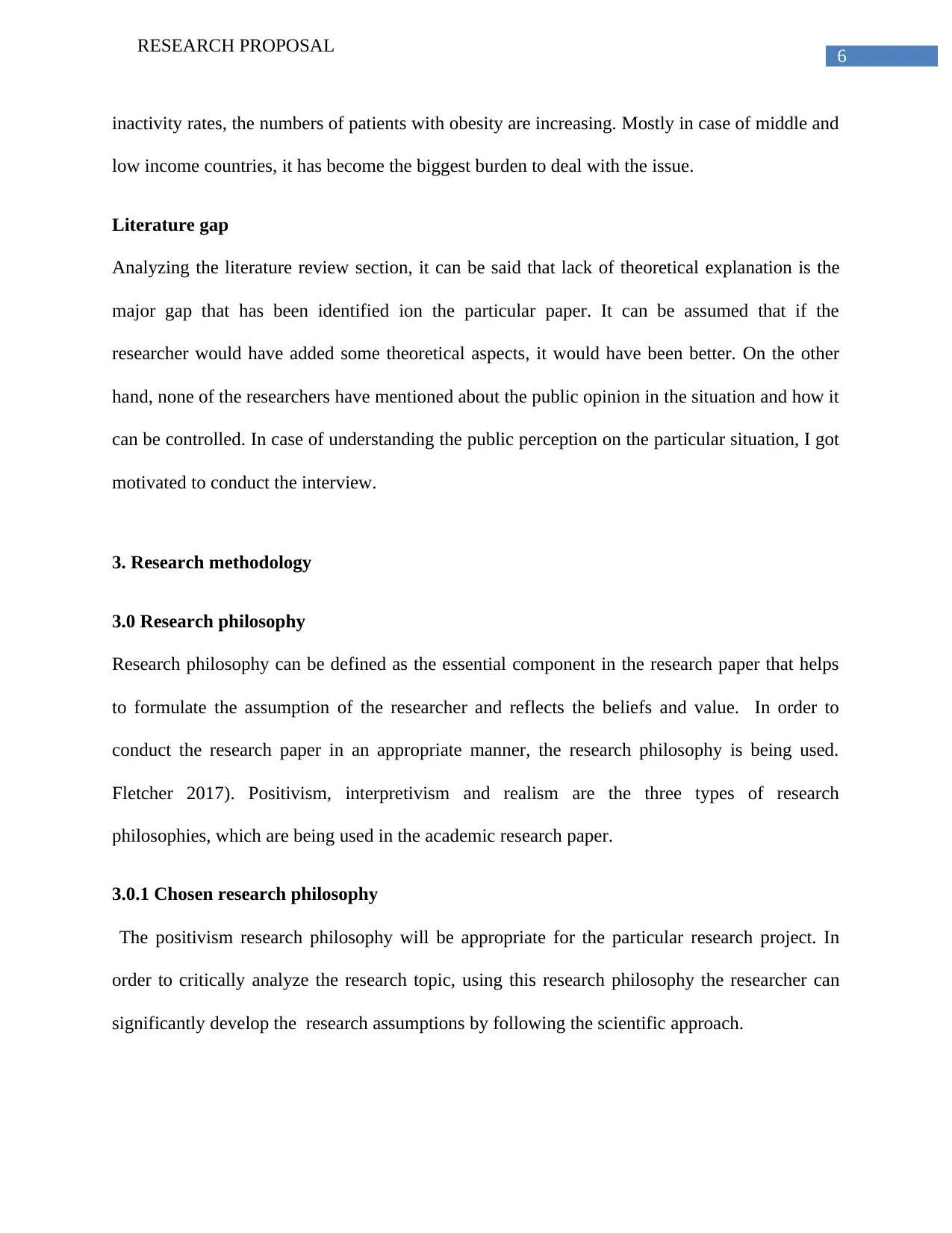
6
RESEARCH PROPOSAL
inactivity rates, the numbers of patients with obesity are increasing. Mostly in case of middle and
low income countries, it has become the biggest burden to deal with the issue.
Literature gap
Analyzing the literature review section, it can be said that lack of theoretical explanation is the
major gap that has been identified ion the particular paper. It can be assumed that if the
researcher would have added some theoretical aspects, it would have been better. On the other
hand, none of the researchers have mentioned about the public opinion in the situation and how it
can be controlled. In case of understanding the public perception on the particular situation, I got
motivated to conduct the interview.
3. Research methodology
3.0 Research philosophy
Research philosophy can be defined as the essential component in the research paper that helps
to formulate the assumption of the researcher and reflects the beliefs and value. In order to
conduct the research paper in an appropriate manner, the research philosophy is being used.
Fletcher 2017). Positivism, interpretivism and realism are the three types of research
philosophies, which are being used in the academic research paper.
3.0.1 Chosen research philosophy
The positivism research philosophy will be appropriate for the particular research project. In
order to critically analyze the research topic, using this research philosophy the researcher can
significantly develop the research assumptions by following the scientific approach.
RESEARCH PROPOSAL
inactivity rates, the numbers of patients with obesity are increasing. Mostly in case of middle and
low income countries, it has become the biggest burden to deal with the issue.
Literature gap
Analyzing the literature review section, it can be said that lack of theoretical explanation is the
major gap that has been identified ion the particular paper. It can be assumed that if the
researcher would have added some theoretical aspects, it would have been better. On the other
hand, none of the researchers have mentioned about the public opinion in the situation and how it
can be controlled. In case of understanding the public perception on the particular situation, I got
motivated to conduct the interview.
3. Research methodology
3.0 Research philosophy
Research philosophy can be defined as the essential component in the research paper that helps
to formulate the assumption of the researcher and reflects the beliefs and value. In order to
conduct the research paper in an appropriate manner, the research philosophy is being used.
Fletcher 2017). Positivism, interpretivism and realism are the three types of research
philosophies, which are being used in the academic research paper.
3.0.1 Chosen research philosophy
The positivism research philosophy will be appropriate for the particular research project. In
order to critically analyze the research topic, using this research philosophy the researcher can
significantly develop the research assumptions by following the scientific approach.
Paraphrase This Document
Need a fresh take? Get an instant paraphrase of this document with our AI Paraphraser
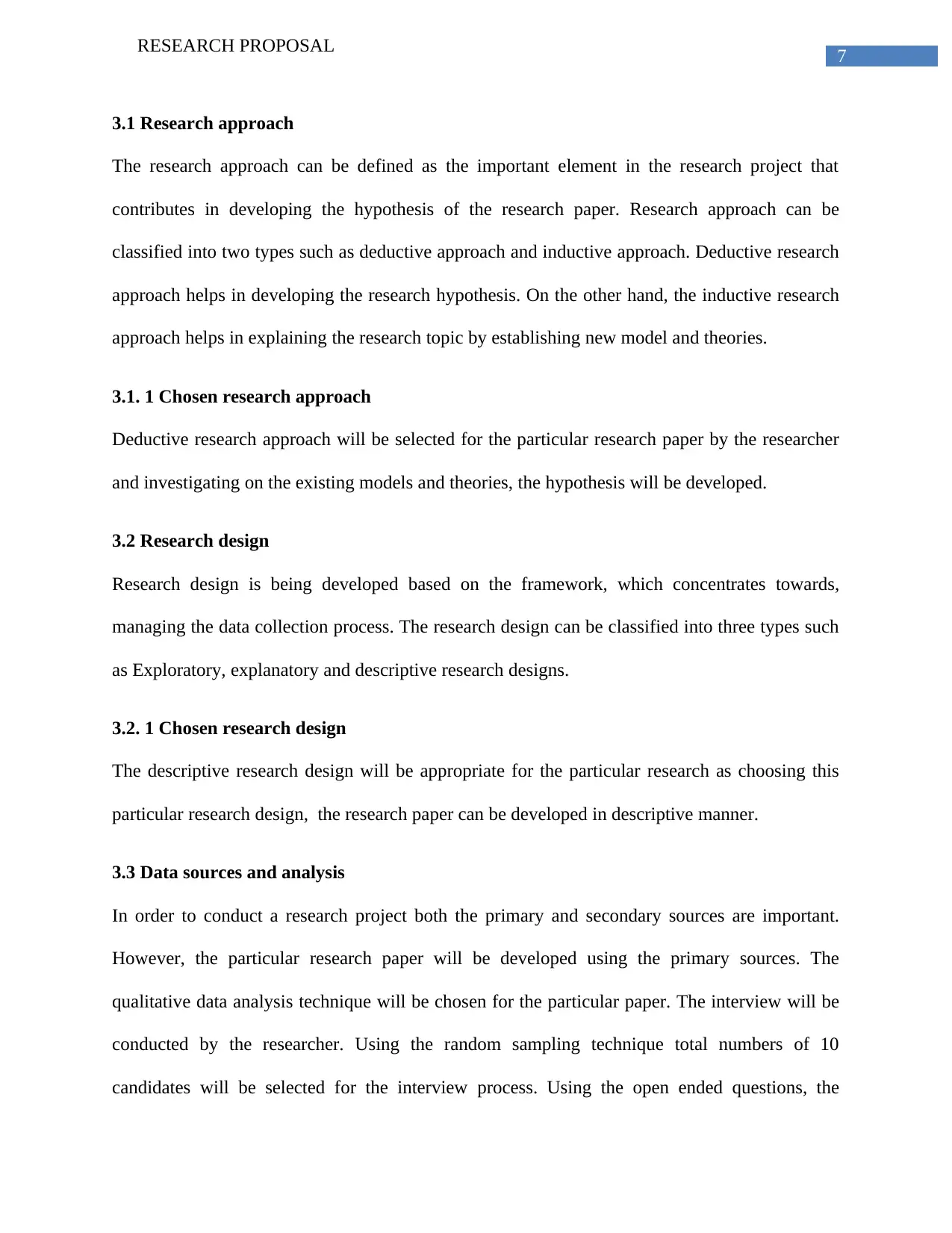
7
RESEARCH PROPOSAL
3.1 Research approach
The research approach can be defined as the important element in the research project that
contributes in developing the hypothesis of the research paper. Research approach can be
classified into two types such as deductive approach and inductive approach. Deductive research
approach helps in developing the research hypothesis. On the other hand, the inductive research
approach helps in explaining the research topic by establishing new model and theories.
3.1. 1 Chosen research approach
Deductive research approach will be selected for the particular research paper by the researcher
and investigating on the existing models and theories, the hypothesis will be developed.
3.2 Research design
Research design is being developed based on the framework, which concentrates towards,
managing the data collection process. The research design can be classified into three types such
as Exploratory, explanatory and descriptive research designs.
3.2. 1 Chosen research design
The descriptive research design will be appropriate for the particular research as choosing this
particular research design, the research paper can be developed in descriptive manner.
3.3 Data sources and analysis
In order to conduct a research project both the primary and secondary sources are important.
However, the particular research paper will be developed using the primary sources. The
qualitative data analysis technique will be chosen for the particular paper. The interview will be
conducted by the researcher. Using the random sampling technique total numbers of 10
candidates will be selected for the interview process. Using the open ended questions, the
RESEARCH PROPOSAL
3.1 Research approach
The research approach can be defined as the important element in the research project that
contributes in developing the hypothesis of the research paper. Research approach can be
classified into two types such as deductive approach and inductive approach. Deductive research
approach helps in developing the research hypothesis. On the other hand, the inductive research
approach helps in explaining the research topic by establishing new model and theories.
3.1. 1 Chosen research approach
Deductive research approach will be selected for the particular research paper by the researcher
and investigating on the existing models and theories, the hypothesis will be developed.
3.2 Research design
Research design is being developed based on the framework, which concentrates towards,
managing the data collection process. The research design can be classified into three types such
as Exploratory, explanatory and descriptive research designs.
3.2. 1 Chosen research design
The descriptive research design will be appropriate for the particular research as choosing this
particular research design, the research paper can be developed in descriptive manner.
3.3 Data sources and analysis
In order to conduct a research project both the primary and secondary sources are important.
However, the particular research paper will be developed using the primary sources. The
qualitative data analysis technique will be chosen for the particular paper. The interview will be
conducted by the researcher. Using the random sampling technique total numbers of 10
candidates will be selected for the interview process. Using the open ended questions, the
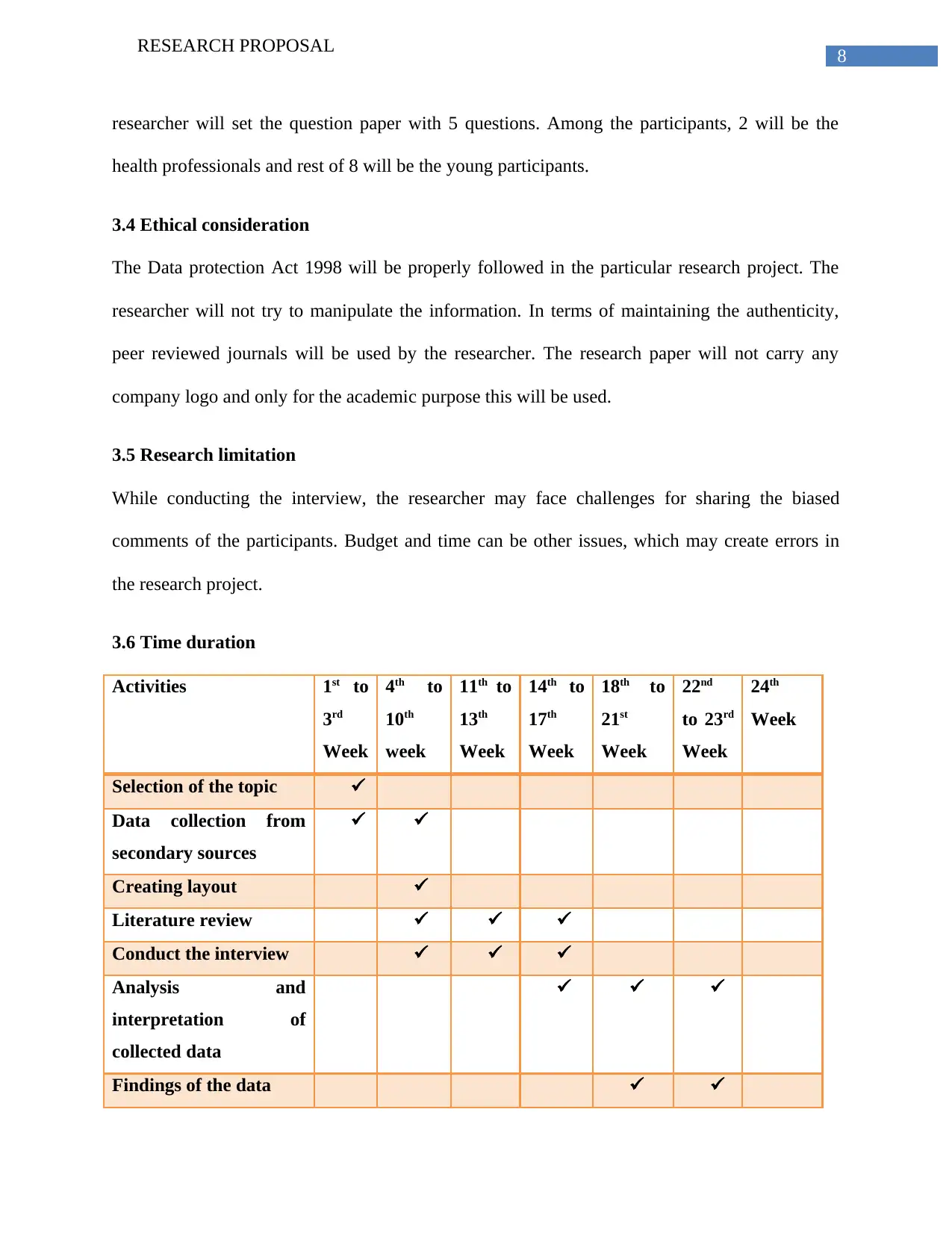
8
RESEARCH PROPOSAL
researcher will set the question paper with 5 questions. Among the participants, 2 will be the
health professionals and rest of 8 will be the young participants.
3.4 Ethical consideration
The Data protection Act 1998 will be properly followed in the particular research project. The
researcher will not try to manipulate the information. In terms of maintaining the authenticity,
peer reviewed journals will be used by the researcher. The research paper will not carry any
company logo and only for the academic purpose this will be used.
3.5 Research limitation
While conducting the interview, the researcher may face challenges for sharing the biased
comments of the participants. Budget and time can be other issues, which may create errors in
the research project.
3.6 Time duration
Activities 1st to
3rd
Week
4th to
10th
week
11th to
13th
Week
14th to
17th
Week
18th to
21st
Week
22nd
to 23rd
Week
24th
Week
Selection of the topic
Data collection from
secondary sources
Creating layout
Literature review
Conduct the interview
Analysis and
interpretation of
collected data
Findings of the data
RESEARCH PROPOSAL
researcher will set the question paper with 5 questions. Among the participants, 2 will be the
health professionals and rest of 8 will be the young participants.
3.4 Ethical consideration
The Data protection Act 1998 will be properly followed in the particular research project. The
researcher will not try to manipulate the information. In terms of maintaining the authenticity,
peer reviewed journals will be used by the researcher. The research paper will not carry any
company logo and only for the academic purpose this will be used.
3.5 Research limitation
While conducting the interview, the researcher may face challenges for sharing the biased
comments of the participants. Budget and time can be other issues, which may create errors in
the research project.
3.6 Time duration
Activities 1st to
3rd
Week
4th to
10th
week
11th to
13th
Week
14th to
17th
Week
18th to
21st
Week
22nd
to 23rd
Week
24th
Week
Selection of the topic
Data collection from
secondary sources
Creating layout
Literature review
Conduct the interview
Analysis and
interpretation of
collected data
Findings of the data
⊘ This is a preview!⊘
Do you want full access?
Subscribe today to unlock all pages.

Trusted by 1+ million students worldwide
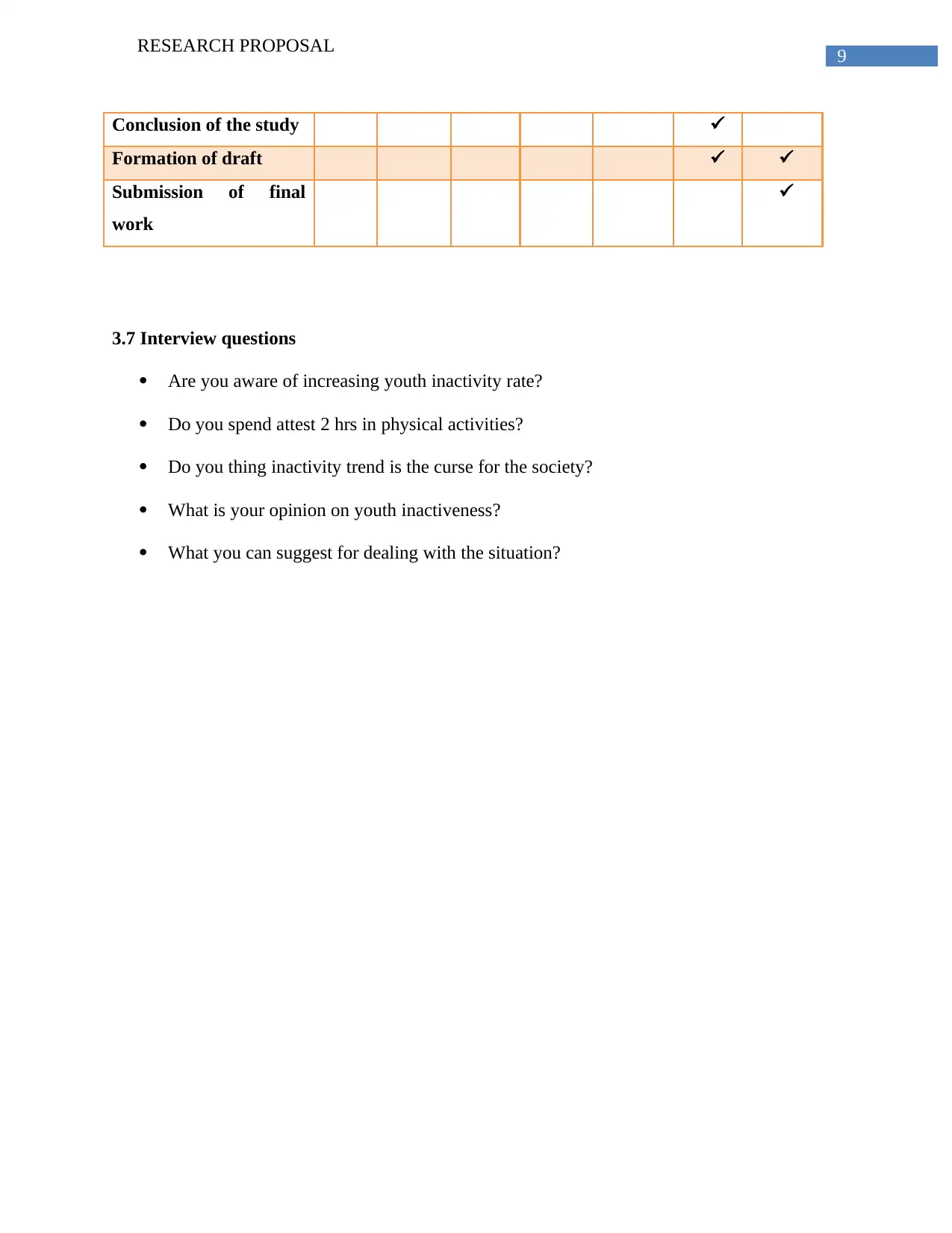
9
RESEARCH PROPOSAL
Conclusion of the study
Formation of draft
Submission of final
work
3.7 Interview questions
Are you aware of increasing youth inactivity rate?
Do you spend attest 2 hrs in physical activities?
Do you thing inactivity trend is the curse for the society?
What is your opinion on youth inactiveness?
What you can suggest for dealing with the situation?
RESEARCH PROPOSAL
Conclusion of the study
Formation of draft
Submission of final
work
3.7 Interview questions
Are you aware of increasing youth inactivity rate?
Do you spend attest 2 hrs in physical activities?
Do you thing inactivity trend is the curse for the society?
What is your opinion on youth inactiveness?
What you can suggest for dealing with the situation?
Paraphrase This Document
Need a fresh take? Get an instant paraphrase of this document with our AI Paraphraser
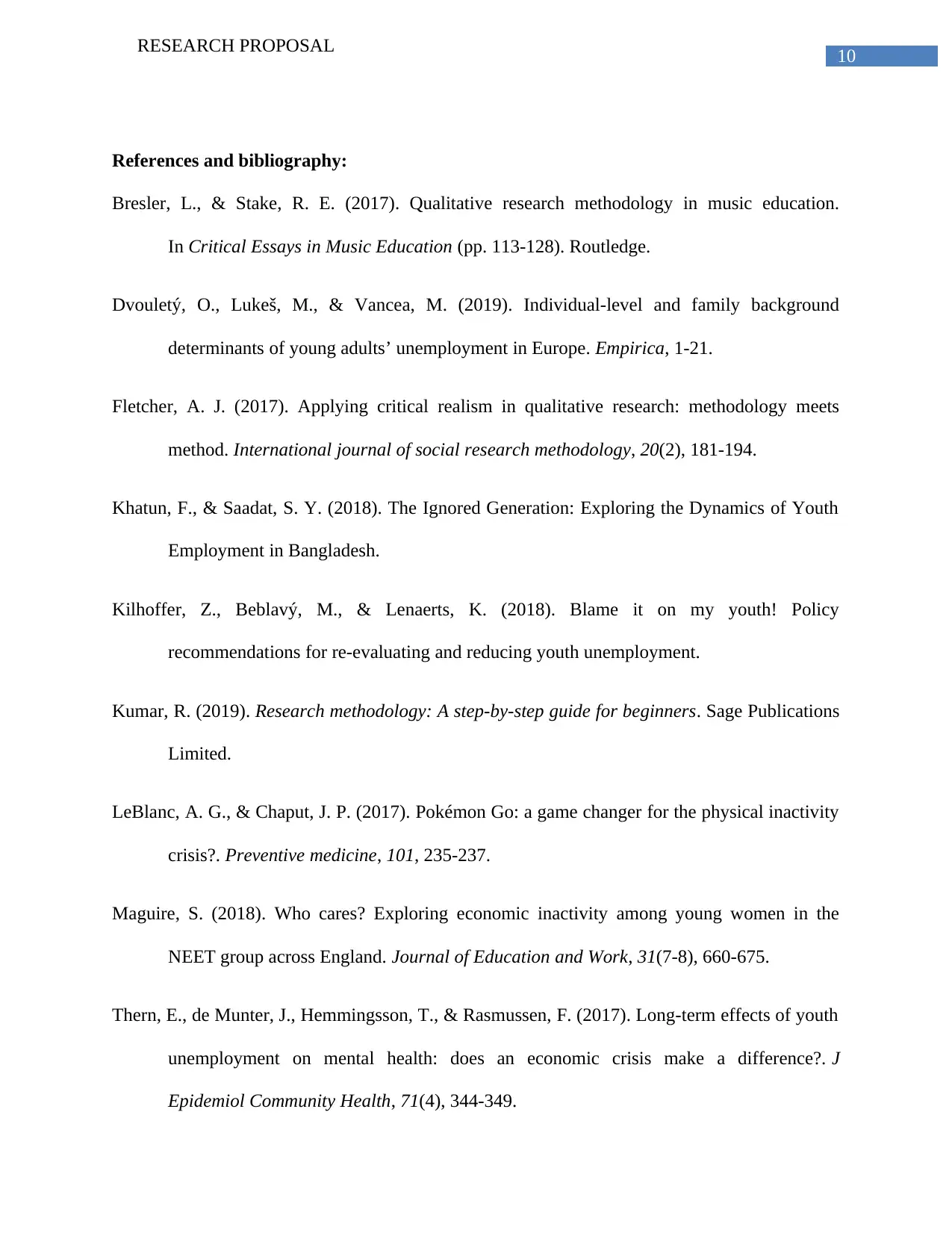
10
RESEARCH PROPOSAL
References and bibliography:
Bresler, L., & Stake, R. E. (2017). Qualitative research methodology in music education.
In Critical Essays in Music Education (pp. 113-128). Routledge.
Dvouletý, O., Lukeš, M., & Vancea, M. (2019). Individual-level and family background
determinants of young adults’ unemployment in Europe. Empirica, 1-21.
Fletcher, A. J. (2017). Applying critical realism in qualitative research: methodology meets
method. International journal of social research methodology, 20(2), 181-194.
Khatun, F., & Saadat, S. Y. (2018). The Ignored Generation: Exploring the Dynamics of Youth
Employment in Bangladesh.
Kilhoffer, Z., Beblavý, M., & Lenaerts, K. (2018). Blame it on my youth! Policy
recommendations for re-evaluating and reducing youth unemployment.
Kumar, R. (2019). Research methodology: A step-by-step guide for beginners. Sage Publications
Limited.
LeBlanc, A. G., & Chaput, J. P. (2017). Pokémon Go: a game changer for the physical inactivity
crisis?. Preventive medicine, 101, 235-237.
Maguire, S. (2018). Who cares? Exploring economic inactivity among young women in the
NEET group across England. Journal of Education and Work, 31(7-8), 660-675.
Thern, E., de Munter, J., Hemmingsson, T., & Rasmussen, F. (2017). Long-term effects of youth
unemployment on mental health: does an economic crisis make a difference?. J
Epidemiol Community Health, 71(4), 344-349.
RESEARCH PROPOSAL
References and bibliography:
Bresler, L., & Stake, R. E. (2017). Qualitative research methodology in music education.
In Critical Essays in Music Education (pp. 113-128). Routledge.
Dvouletý, O., Lukeš, M., & Vancea, M. (2019). Individual-level and family background
determinants of young adults’ unemployment in Europe. Empirica, 1-21.
Fletcher, A. J. (2017). Applying critical realism in qualitative research: methodology meets
method. International journal of social research methodology, 20(2), 181-194.
Khatun, F., & Saadat, S. Y. (2018). The Ignored Generation: Exploring the Dynamics of Youth
Employment in Bangladesh.
Kilhoffer, Z., Beblavý, M., & Lenaerts, K. (2018). Blame it on my youth! Policy
recommendations for re-evaluating and reducing youth unemployment.
Kumar, R. (2019). Research methodology: A step-by-step guide for beginners. Sage Publications
Limited.
LeBlanc, A. G., & Chaput, J. P. (2017). Pokémon Go: a game changer for the physical inactivity
crisis?. Preventive medicine, 101, 235-237.
Maguire, S. (2018). Who cares? Exploring economic inactivity among young women in the
NEET group across England. Journal of Education and Work, 31(7-8), 660-675.
Thern, E., de Munter, J., Hemmingsson, T., & Rasmussen, F. (2017). Long-term effects of youth
unemployment on mental health: does an economic crisis make a difference?. J
Epidemiol Community Health, 71(4), 344-349.
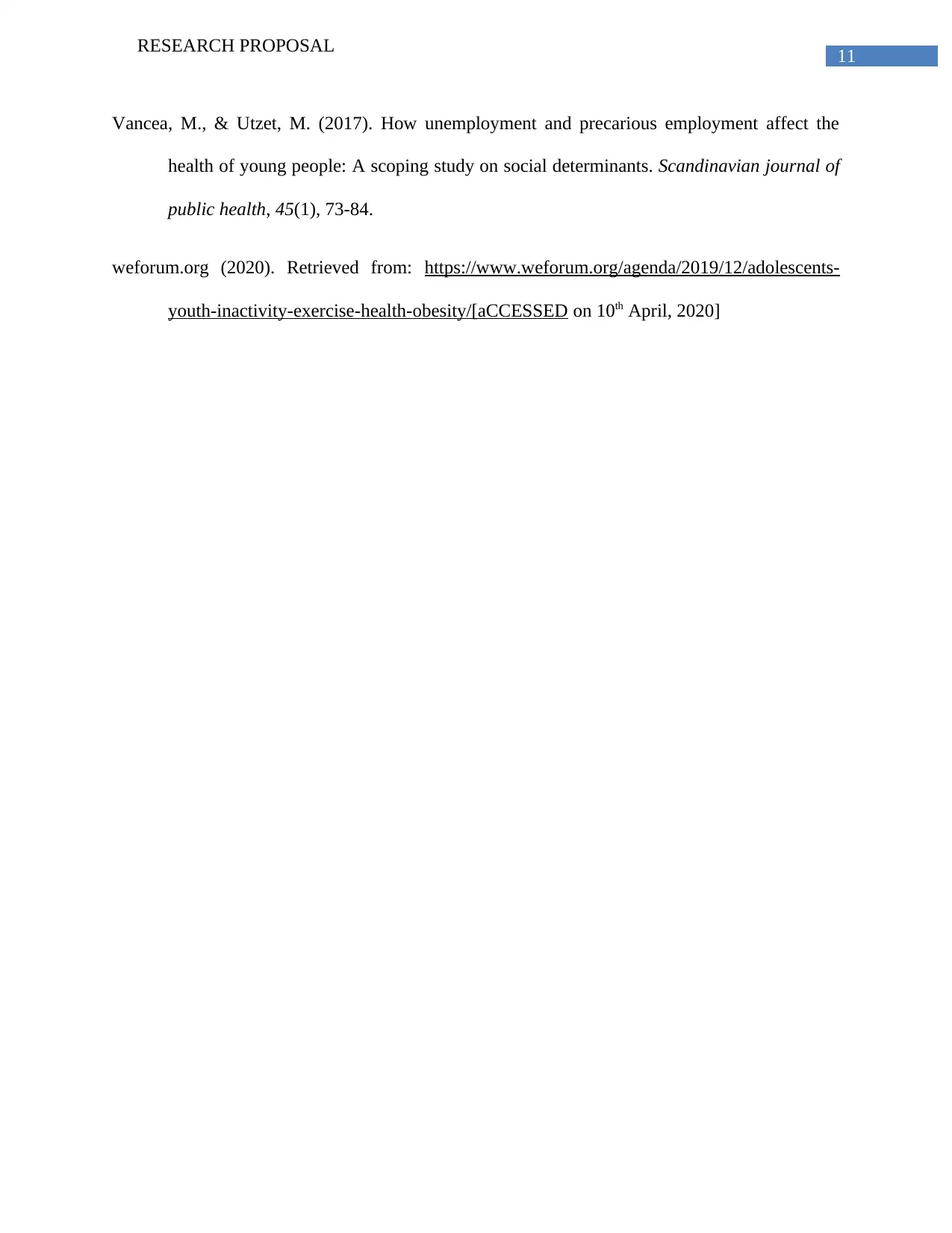
11
RESEARCH PROPOSAL
Vancea, M., & Utzet, M. (2017). How unemployment and precarious employment affect the
health of young people: A scoping study on social determinants. Scandinavian journal of
public health, 45(1), 73-84.
weforum.org (2020). Retrieved from: https://www.weforum.org/agenda/2019/12/adolescents-
youth-inactivity-exercise-health-obesity/[aCCESSED on 10th April, 2020]
RESEARCH PROPOSAL
Vancea, M., & Utzet, M. (2017). How unemployment and precarious employment affect the
health of young people: A scoping study on social determinants. Scandinavian journal of
public health, 45(1), 73-84.
weforum.org (2020). Retrieved from: https://www.weforum.org/agenda/2019/12/adolescents-
youth-inactivity-exercise-health-obesity/[aCCESSED on 10th April, 2020]
⊘ This is a preview!⊘
Do you want full access?
Subscribe today to unlock all pages.

Trusted by 1+ million students worldwide
1 out of 12
Related Documents
Your All-in-One AI-Powered Toolkit for Academic Success.
+13062052269
info@desklib.com
Available 24*7 on WhatsApp / Email
![[object Object]](/_next/static/media/star-bottom.7253800d.svg)
Unlock your academic potential
Copyright © 2020–2025 A2Z Services. All Rights Reserved. Developed and managed by ZUCOL.




